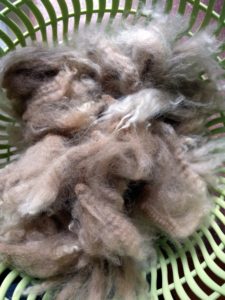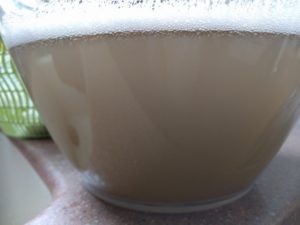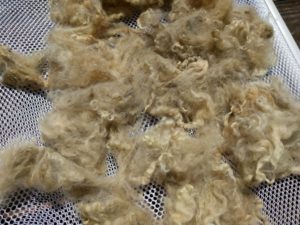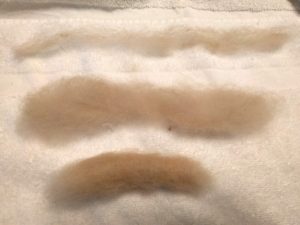One of the joys of working with already prepared fiber is that you get to skip the dirty work. You just simply sit down with your wheel or spindle and start spinning. But most well-advanced spinners will say that at some point you’ll want to start from a raw fleece.
Why? Well, my understanding is that it all has to do with getting exactly the yarn you want for the project you have in mind. For some knitters (and weavers), that’s why they get into spinning in the first place – to control the yarn creation so that it’s absolutely perfect for their finished projects. So going one step further into the yarn-making process is just another way to control the outcome.
For me? Not so much. It’s all about learning a new creative skill first, then being able to control my output second. I’m not exclusively spinning to knit at this point – though I have taken that particular track at least once, and have plans for more. I’m spinning for the joy of making yarn and to explore each of the ways of doing that.
Enter the raw fleece. An alpaca fleece, to be exact. Why alpaca and not wool? For the simple reason that it was a handy acquisition at just the time when I was interested in acquiring a fleece. I could just as easily have waited until the fiber festivals this summer/fall and picked up a wool fleece then. But it was right there, in my hands, and I couldn’t resist. It was also just the right size – 1 lb – not so small that there wasn’t enough for a good experiment, and not so large as to be absolutely overwhelming. (For comparison, some fleeces can weigh in the double digits.)
I pulled out a 1 ounce sample of the raw fleece to prep it for the first bath. Skirting involves pulling out all of the bits of hay, grass, twigs, etc. that gets caught in the fiber during the everyday goings-on of the animal. Then the fiber goes into the bath for a first soak. Let me tell you, that is one dusty fleece. So much sediment in the bathwater! Then it is laid out to air dry.
I decided to try different fiber prep and spinning methods to see which ones I liked for this project. I combed a handful of the locks, to test how the ends open up. This makes the fiber really fluff up, while keeping the individual hairs running in the same direction.
I also tried carding the fiber. This also fluffed the fiber, and the hairs mostly stayed oriented in the same direction. My technique needs some practice. The thing with carding is that you can either roll the fiber “mat” off the cards longways or shortways, with each one giving you a different result during the spinning. I got a better roll with removing the fiber starting from one short end and rolling across to the other short end. Alpaca has a hard time sticking to itself, so rolling the fiber off the card in the traditional manner (from long side to long side – to make what is called a rolag) just gave me a long skinny cloud that tended to fall apart.
Here are my prep experiments lined up for inspection. On the top is the combed locks experiment, pre-drafted through a buttonhole to make it ready for spinning. In the middle is the carded experiment where I rolled the fiber off the cards in the traditional way to make a rolag. At the bottom is the carded experiment where I rolled the fiber off the cards from short end to short end.
I decided I liked the bottom version the best. So I prepped the rest of the 1 ounce sample in that manner. I also decided to spin this sample using a long draw woolen technique to deliberately add air to the yarn – in other words, preserving the fluff factor through to the finished product. This also has the benefit of being faster to spin.
The 2-ply unwashed yarn was soft and springy, but had definitely lost the luster of the original locks. There was just too much dust still in the fiber! So I was happy to toss it into the bathwater to set the twist – it would also get rid of all that dirt.
Here’s the finished sample skein. I wish you could feel it. It is so squishy and soft and nearly weightless! That single ounce of fiber spun into ~118 yards of a 2-ply light fingering yarn.
But the experiments don’t stop there. Next up: A sample of the combed locks spun in my default worsted spinning technique. Will it turn out as smooth and silky as expected?






One Response to Leveling Up